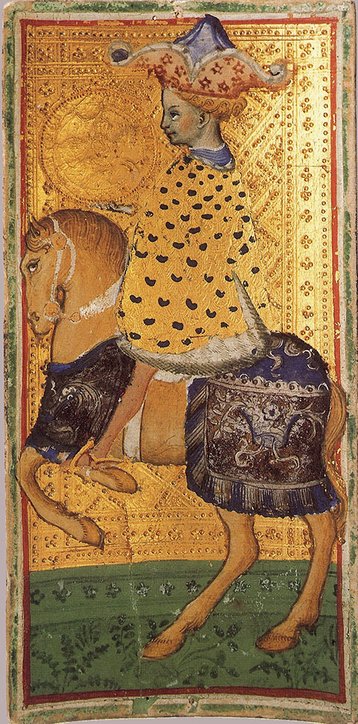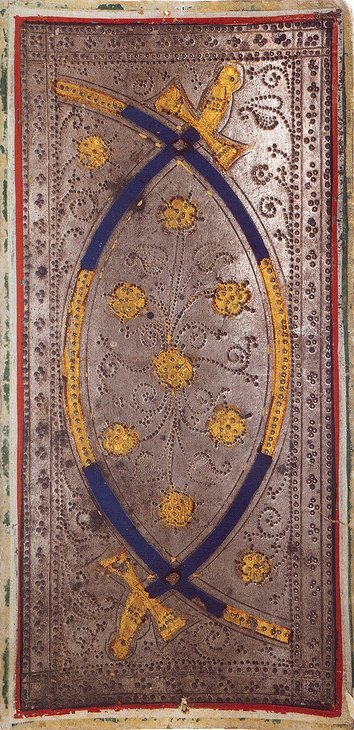THE TAROT WHEEL
INTRODUCTION TO THE VISCONTI-SFORZA DECK - 5 SUITS OF 14 CARDS
Probably no other card maker ever followed the 5 x 16 suit structure of the Visconti di Modrone deck, that we discussed in the previous section. Not one single evidence in history is pointing in that direction. But also no early sources indicates the contrary. The first hint to a 14 Trump card structure is the 14 illustrations offered to Bianca Maria Sforza on New Year's day of 1441. It might have nothing to do with the Trionfi structure, but the number 14 is significant, clearly a hint in this sense.
Since the earliest references to playing cards, almost all popular European card games had 13 or 14 cards per suit. To make a card game popular, it would have made sense not to change this number of suit cards.
In the early years of 1450, the Visconti-Sforza cards have been produced. Of the surviving cards of this deck, 6 Trump cards have a different style and were realized later in the same Century. Are these 6 cards replacement or additional cards? As we will see in this section, the 14 earlier Trumps have a strong and complete structure, where no card is missing.
In 1557 the account books of the court of Este mention the purchase of a complete Trionfi deck of 70 cards. For me, this is the most convincing evidence that up to 1557 the structure of a Trionfi deck consisted of 5 suits, each with exactly 14 cards. This includes the Trump suit. The first real evidence we have of a possible 78 cards structure (22 Trump cards and 4 suits of 14 cards) is the appearance of the two Estensi decks, commissioned probably both by Ercole I d'Este (one deck made in 1473 on the occasion of his marriage and the other, the so-called Charles VI deck, maybe earlier, but if it is indeed him who commissioned the deck, not before 1460, the year when he returned from Naples to Ferrare). The cards, that were added to the Visconti-Sforza deck, very probably post-date the Estensi decks.
The Estensi decks have another particularity, no pip-cards are known for these decks. Because the handpainted cards were extremely expensive and probably only made for display, it is possible that the pip-cards were not ordered, beause they did not have enough possibilities to display family symbols or known persons. So they were no good showcases. Recent studies have shown that the goldfoil on the Visconti-Sforza pip cards consist of pure gold, where the original trump and court hards have goldfoil consisting of an alloy of gold and silver. Also the goldfoil on the six added cards is made from pure gold. So for me it is very probable that the added trump ards and the pip ards were made at the same time.
The Visconti and Este families were very close. Even if the men could be against each other on the battlefield, the women always were close. Bianca Maria Visconti and Beatrice d'Este were bosom friends, and Beatrice, like Bianca Maria, married into the Sforza family. So, they knew each other's versions of the Trionfi decks very well.
Whatsoever, we have to work with the evidence we have. In the seven court cards, there are no female horse riders, nor servants. If they were present, the chance that none of them would survive in the 7 remaining cards is only 3,3%. Still, this is possible. There are also no court cards representing the suit of Swords. With a 14 cards per suit structure, this chance would have been 7 %. With a 16 cards per suit structure, this particular outcome (no female horse riders, no servants and no court cards from the suit of swords) had only a 0,2 % chance to produce itself. So, we can state with more than 95% of confidence, that the Brera Brambilla deck had only 14 cards per suit. In correspondence with the Visconti di Modrone deck, where the Trump suit have the same number of cards as the regular suits, we conclude that probably, there were only 14 Trump cards. This agrees with the account book of the Estensi mentioning the purchase of a complete Trionfi deck consisting of 70 cards. In the Brere Brambilla deck, there are only 2 Trump cards surviving, the Emperor, both present on earlier and later decks and the Wheel of Fortune, present on later decks and maybe also (but not surviving, it is only a hypothesis) on the Visconti di Modrone. So, this does not give us any useful information.
The pip cards of the Brere Brambilla deck are made in the same style as the pip cards of the Visconti di Modrone deck, made by an identical process and in the same colors. Here at the left the 2 of Swords as an example. But in detail there are many differences.
Coins. The cards are almost identical to the Visconti di Modrone deck. In contrary to the older deck, there are no special fancy cards for the one or two of Coins.
Cups. The Ace of Cups is different on both decks. But slowly these differences become less apparent and starting from the six of cups, both decks are almost identical.
Batons. Arrows appear on the numerals of the Visconti di Modrone pip cards and on the Brere Brambilla Court cards. Scepters are represented on the Visconti di Modrone Court cards and on the numbered cards of the Brere Brambilla deck.
Swords. No hand is holding the Ace of Swords on the Brere Brambilla deck. All further Sword cards are curved on the Brere Brambilla deck and straight on the Visconti di Modrone deck.
Several years after the death of her father, Bianca Maria Visconti was probably the driving force behind a new Trionfi deck. This deck has maybe been commissioned to celebrate the 10 years of marriage between Bianca Maria and Francesco Sfroza. In any case, we are well before 1457 and the standard structure by that time was 70 cards. There are fourteen original trump cards, the other six trumps we know today have been added at a later date to the deck. We have no evidence that these cards were replacement cards. As we will see here below, the structure of the fourteen original Visconti Sforza Trump cards is well-designed and logic. There are two groups of six cards, with each group topped up by a card representing Justice. However, as we will saw here above, the original Visonti-Sforza deck was probably not complete, the pip cards might have been added later.
In the last years of his life, Filippo Maria Visconti commissioned another hand painted Trionfi deck. We don't know, at which occasion. In contrary to the Visconti di Modrone deck, heraldic symbols are very rare. They are restricted to the tissues covering the horses of the Knights (as we can see at the figure at the right representing the knight of Coins) and to some rare banners on the pip cards. No heraldic symbols appear on the clothing of the figures on the court cards. There are 39 pip cards surviving, 7 court cards and only 2 Trump cards. The deck is commonly called the Brera-Brambilla Visconti deck. Several theories are possible, maybe the deck has never been finished due to the early death of the Duke or maybe the remaining cards have been destroyed during the subsequent riot on the Visconti Castle. We will never know.
The fourteen Trumps of the original Visconti-Sforza deck have a clear educational message. The very religious Bianca Maria Visconti, maybe wanted a tool, that could help her to educate her children. When the Trionfi deck was created, her first child, Galeazzo Maria Sforza, was about 7 to 9 years old. She had already such a tool in the Visconti di Modrone deck, that she got as a wedding present. This was a perfect tool to educate her children in the virtues, to educate them how to behave, But she needed a second tool, more practical, to explain to her children the organization of society and the pitfalls in daily life. Her father had started the creation of such a tool, with the deck we call now the Brera-Brambilla deck. But assuming that the premature death of her father left this deck unfinished, instead of completing the deck commissioned by the Duke Filippo Maria Visconti, it might be possible that her husband, Francesco Sforza, the new Duke of Milan, wanted to have a new deck created, related to his own reign, with a strong message for his children.
The fourteen Trumps pf the Visconti-Sforza deck have a clear structure. They are organized in seven pairs divided over two groups. These two groups consist of seven cards each, each group with three pairs that are topped up by a seventh card. The seventh card of both groups also form a pair together. The first group of six cards represents the Estates of the Realm, the medieval division of Society in three layers, consisting of Commoners, Nobility and Clergy. We come later back in detail to these cards. The second group of six cards represents the internal and external powers that influence our life. The first pair consists of internal influences that we should handle by ourselves, sexual desire and the will to dominate others. The two other pairs represent the external influences that are beyond our control, luck or destiny, the aging process, accidents and illnesses and finally death. So, the first group of cards is explaining how society is organized, and the second group of cards is giving advice how to organize your life, and how to be prepared for the events that will happen during our lives. Both groups of six cards are accompanied by a seventh card representing Justice. The first group is topped up by Justice in our world, and the second group by God's Justice. These two Justice cards emphasize that Justice is independent, and that nobody can escape the power of Justice. Even the most clever man, who commits a perfect crime, if the world's Justice won't be able to condemn him for his crimes, God is there for the final and definitive act of Justice. God is everywhere, God knows everything, you cannot hide anything for Him, you cannot hide or escape, Justice will be done.



